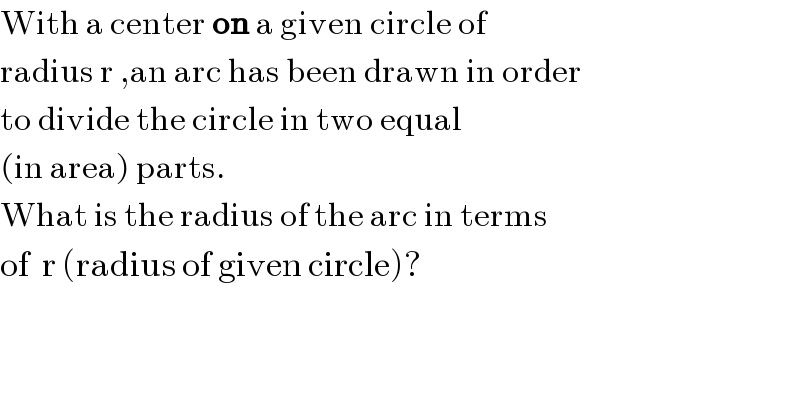Question Number 26772 by Rasheed.Sindhi last updated on 29/Dec/17

Answered by mrW1 last updated on 29/Dec/17
![Let′s say the radius of the circle is r and the radius of the arc is R. The angle of the arc is θ. r cos (θ/2)=(R/2) ⇒R=2r cos (θ/2) (ϕ/2)=π−2×(θ/2) ⇒ϕ=2π−2θ area of segment of arc BC: A_1 =(R^2 /2)(θ−sin θ)=2r^2 cos^2 (θ/2)(θ−sin θ) area of segment of circle BAC: A_2 =(r^2 /2)[2π−2θ−sin (2π−2θ)]=r^2 (π−θ+sin θ cos θ) A_1 +A_2 =((πr^2 )/2) 2r^2 cos^2 (θ/2)(θ−sin θ)+r^2 (π−θ+sin θ cos θ)=((πr^2 )/2) (cos θ+1)(θ−sin θ)+(π/2)−θ+sin θ cos θ=0 sin θ−θ cos θ=(π/2) ⇒θ≈1.9057 (109.2°) ⇒R=2rcos (θ/2)≈1.16r If the arc divides the area of the circle in ratio λ:1, then the equation is sin θ−θ cos θ=(1−λ)π ⇒λ=1−((sin θ−θ cos θ)/π) cos (θ/2)=(R/(2r))=γ ⇒θ=2 cos^(−1) γ sin (θ/2)=(√(1−γ^2 )) ⇒sin θ=2γ(√(1−γ^2 )) ⇒cos θ=2γ^2 −1 ⇒λ=f(γ)=1−((2γ(√(1−γ^2 ))−2(2γ^2 −1) cos^(−1) γ)/π)](https://www.tinkutara.com/question/Q26773.png)
Commented by mrW1 last updated on 29/Dec/17

Commented by Rasheed.Sindhi last updated on 29/Dec/17

Commented by mrW1 last updated on 29/Dec/17

Commented by mrW1 last updated on 30/Dec/17

Commented by Rasheed.Sindhi last updated on 30/Dec/17

Commented by Rasheed.Sindhi last updated on 30/Dec/17

Commented by mrW1 last updated on 30/Dec/17

Commented by Rasheed.Sindhi last updated on 30/Dec/17

Commented by prakash jain last updated on 30/Dec/17

